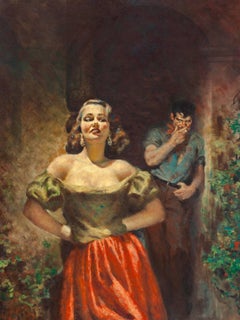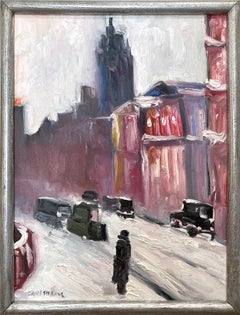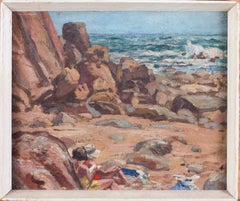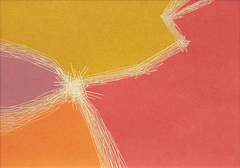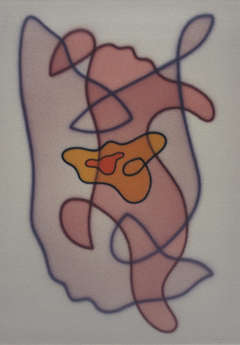Raymond Jonson Paintings
American, 1891-1992
Raymond Jonson (1891-1982) is best known as one of the founders of the Transcendental Painters Group in Santa Fe, where he settled in 1924 and painted works that were pure abstraction. Before this time, he was in Chicago for fourteen years and there had many formative experiences that led to his later career. His mentor in Chicago was modernist B.J.O. Nordfeldt, and he was much affected by the Armory Show Exhibition of 1913 when it traveled to Chicago.to
2
Overall Width
to
Overall Height
to
2
1
1
2
1
1
1
1
2
1
1
1
1
2
781
718
711
695
2
2
Artist: Raymond Jonson
The Naked Rich, Paperback Cover
By Raymond Jonson
Located in Fort Washington, PA
Date: 1953
Medium: Oil on Canvas Laid on Board
Dimensions: 27.50" x 21.25"
Signature: Titled and Dated '1952' Verso
This illustration was published as the cover for The Naked R...
Category
1950s Raymond Jonson Paintings
Materials
Canvas, Oil, Board
Raymond Jonson Abstract Watercolor, 1941 - Casein Tempera No. 1
By Raymond Jonson
Located in Phoenix, AZ
Great abstract work by Transcendental painter Raymond Jonson (1891-1982)
Titled: “Casein Tempera No. 1”. Medium: Tempera. Dated: 1941.
Image measures: 30" H x 22" W. Frame measures: ...
Category
Mid-20th Century Abstract Raymond Jonson Paintings
Materials
Tempera
Related Items
"View of the Empire State NYC in Snow" Impressionistic Ashcan School Style
By Cindy Shaoul
Located in New York, NY
An impressionistic depiction of a figure in the snow with cars and buildings in the busy City Streets. The Empire State Building is portrayed in the background as the snow filled str...
Category
2010s American Impressionist Raymond Jonson Paintings
Materials
Canvas, Oil, Board
$1,200
H 17 in W 13 in D 1.25 in
Pair of early 20th Century British Impressionist paintings of the beach
Located in Petworth, West Sussex
Attributed to Rowland Wheelwright, 20th Century
'Bather's on the shore' and 'Sunbathing by the Cliffs'
Oil on canvas board
9 X 10. 1/4in. (22.8 X 2...
Category
20th Century Impressionist Raymond Jonson Paintings
Materials
Canvas, Oil, Board
$2,483
H 9 in W 10.25 in D 1 in
Evening in Paris - 20th Century Oil, Figures in Cityscape at Night - Louis Hayet
By Louis Hayet
Located in Marlow, Buckinghamshire
A wonderful oil on canvas by Louis Hayet depicting figures in a cityscape at evening time. Signed and dated 1932 lower left.
Louis Hayet had a difficult and itinerant childhood, due to the instability of his father, an amateur artist. He began to draw and produce watercolours from the age of 12. By the age of 20 he produced works with great skill, as demonstrated by his pen drawing Boulevard, Evening, Paris. He made a living in Paris doing various jobs more or less to do with painting. He associated with Camille and Lucien Pissaro...
Category
1930s Post-Impressionist Raymond Jonson Paintings
Materials
Canvas, Oil, Board
"St. Patrick's Cathedral" Impressionist Snow Street Scene Oil on Canvas Board
By Johann Berthelsen, 1883-1972
Located in New York, NY
A stunning and pertinent example of Berthelsen's charming New York City winter scenes depicting St. Patrick's Cathedral in the snow. St. Patrick’s Cathedral is the largest Roman Cath...
Category
Mid-20th Century American Impressionist Raymond Jonson Paintings
Materials
Canvas, Oil, Board
$8,000
H 14 in W 12 in D 1.25 in
Scintillating Light: View from the Hills to the City, a winding path, Madrid
Located in Norwich, GB
A perfectly Impressionistic work with beautifully loose, almost pointillist brushstrokes, focussing on the scintillating light and the remote hilltop atmosphere.
Artist Frans Hog...
Category
1910s Pointillist Raymond Jonson Paintings
Materials
Oil, Board, Canvas
$1,400
H 14.97 in W 19.3 in D 1.19 in
Miniature Original Painting Art Study of Central Park Christmas New York City
By Angela Wakefield
Located in Preston, GB
Miniature Original Painting Art Study of Central Park Christmas in New York City by Contemporary British Artist, Angela Wakefield.
Art measures 5 x 7 inches
Frame size is 11 x 13 ...
Category
2010s Contemporary Raymond Jonson Paintings
Materials
Gesso, Canvas, Wood, Paint, Cotton Canvas, Mixed Media, Oil, Acrylic, Board
$1,275
H 13 in W 11 in D 1.75 in
"Spring Day by the Lake" Post-Impressionist Parisian Country Side Oil Painting
Located in New York, NY
A beautiful oil on board painting by American artist Maurice Monnard. Monnard was a Post-Impressionist painter known for his colorful cityscapes depict...
Category
1970s Post-Impressionist Raymond Jonson Paintings
Materials
Oil, Board, Canvas
$2,500
H 28.25 in W 32.25 in D 2.5 in
Southern City by the sea atmospheric large blue green seascape harbour painting
Located in Norwich, GB
A very atmospheric and idyllic view of a Southern fishing port, painted most likely in Italy or France. Resolutely post-impressionist, the landscape is imbued with the light of the M...
Category
Early 20th Century Post-Impressionist Raymond Jonson Paintings
Materials
Canvas, Oil, Fiberboard
$900
H 29.14 in W 33.86 in D 2.76 in
Afternoon Stroll, American Impressionist, Figure on Forest Path, Landscape
Located in Wiscasset, ME
Juliet M. White was born in Philadelphia in 1880. She studied at the Philadelphia School of Design for Women, which became the largest art school for women in the United States. Its ...
Category
20th Century American Impressionist Raymond Jonson Paintings
Materials
Canvas, Oil, Board
$2,300
H 16.75 in W 14.75 in
In the Bois de Boulogne, Paris, American Impressionist Working in France
By George Raab (b. 1866)
Located in Wiscasset, ME
George Raab was born in 1866 in Sheboygan, Wisconsin. In 1889, Raab and Herman Keiker opened a photographic studio called Feiker and Raab. Less than a year later, Raab would start up...
Category
Late 19th Century Impressionist Raymond Jonson Paintings
Materials
Canvas, Oil, Board
"The Lake & Plaza Hotel New York" Impressionist Oil Painting in Central Park
By Johann Berthelsen, 1883-1972
Located in New York, NY
A stunning jewel and pertinent example of Berthelsen's charming New York City scenes. Here we find a The Plaza hotel and the Manhattan buildings depicted in the far background with pops of colors shinning through the lights and magic of the city. The artist was truly a master of capturing New York in all of its glory throughout the seasons. This piece is executed whimsically, yet dramatically evoking an emotion of wonder and beauty. This piece is signed lower right by the artist and it also bears the reproduction right's stamp on the reverse. It is titled on the back and it comes housed in a beautiful French giltwood frame with linen liner and hanging wire on verso ready to be displayed.
Art measures 6.5 x 8 inches
Frame measures 12 x 14 inches
Johann Berthelsen was born in Copenhagen in 1883, the 7th of seven children, to Conrad and Dorothea Karen Berthelsen. His parents were involved in artistic and professional circles. In 1890, his mother brought the children to America, settling in Manistee, Michigan, with her sister's family. They would eventually move to Manitowoc, Wisconsin, a city on the shore of Lake Michigan. As a teenager, Johann was actively involved in choirs and singing groups. And he always loved to draw and paint, and while he was too impatient to take well to schoolwork, and never went beyond the 5th grade.
Although he worked in several trades, Johann's mind and heart were always with the arts. As his voice matured, he also always wanted to be an actor, and at the age of 18 moved to Chicago where he reconnected with an old friend who was studying voice at the Chicago Musical...
Category
Mid-20th Century American Impressionist Raymond Jonson Paintings
Materials
Canvas, Oil, Board
$8,500
H 12 in W 14 in D 1.25 in
"Bastille Paris" Oil on Canvas Parisian Street Scene & Figures Framed Painting
Located in New York, NY
A vibrant and colorful Parisian city scene by Australian Mollie Flaxman. Captured in a very impressionist manner 'The Bastille' which was a fortress in Paris, known formally as the B...
Category
Mid-20th Century Impressionist Raymond Jonson Paintings
Materials
Oil, Board, Canvas
$1,500
H 21.5 in W 25.5 in D 1.75 in
Previously Available Items
Oil No. 9
By Raymond Jonson
Located in Denver, CO
Framed dimensions measure 23.5 x 31.5 inches.
Expedited and International Shipping available; please contact us for a quote.
About the artist:
Seeking the spiritual in art, Raymond Jonson developed an abstract style of painting that was unique in pre-1940s New Mexico. While his colleagues in the Transcendentalist Painting Group similarly shared his interest in the metaphysical, Jonson alone found his means in a non-objective relationship of forms. Strongly influenced by Kandinsky, the painter moved from stylized representations of nature to formalist expressions of universal harmony. In order to achieve his aims, he became a master of materials, known for his meticulous working methods.
Born in Iowa, Jonson spent his early years moving around the country with his family, necessitated by his minister father's work. They finally settled in Portland, Oregon, in 1902, and this same year Raymond had a spiritual experience in which he sensed the presence of God. When his family's Baptist faith disappointed him, he transposed this feeling to art, to which he committed his life. When the Portland Art Association established its Museum Art School, Jonson enrolled as its first student.
His dedication led him to Chicago to study at the Academy of Fine Arts, a very good commercial school, which afforded a strong grounding in drawing. Here he met B.J.O. Nordfedlt, a Swedish immigrant, who introduced the younger Jonson to the colorist experimentation of the Fauves. The Arthur Dove exhibition and the Armory Show brought to Chicago both expanded his awareness of the emotive possibilities of modernist art movements.
From 1912 to 1917, Jonson was lighting, stage set, costume, and graphics designer for the Chicago Little Theater, America's first experimental theater. Among their bold departures was a minimalist aesthetic, which reduced the stage elements and enhanced the dramatic content with light. Devising the 9-switch dimmer board, Jonson (going by C. Raymond Johnson) became an international theater figure. He also met his wife, Vera White, secretary for the theater and poet.
On a trip to the Colorado Rockies in 1917, Jonson was moved by the power of this sublime landscape and its clarity of light. He began to consider how paint could express light -- material into immaterial. Teaching at the Chicago Art Institute, he was able to get away to the MacDowell Art Colony in 1919, and his elevated sensibilities increasingly perceived the oppressive side of city life. Believing the aim of life was toward harmony, Jonson placed new emphasis on design as a unifying principle. Reading Kandinsky's "The Art of Spiritual Harmony" further convinced him that the mission of art was to make this harmony visible.
In 1922, he spent the entire summer in Santa Fe, and his experience there filtered into his work upon returning to Chicago. When his mother supplied the money for a studio, he moved to New Mexico in 1924, building his home across the street from his friend Nordfeldt. Jonson pursued the concept of order as found in "simple basic motives of spaces and interesting variety of shapes and spaces, a balance of line direction."
In the work of the late 20s, he submits natural forms, such as mesas and even the Grand Canyon, to a dynamic patterning in which the quality of light becomes a design element. Significantly, Jonson thought that emotion could be included by creating juxtaposed rhythms within the composition. Influenced by Indian design, these paintings recall Art Deco ornamentation in the combination of organic and geometric motifs and the electric color effects.
Taking the next leap, Jonson set about purifying his work of all representation. Beginning in the thirties, he explored new ways applications of color and tonality to suggest the quality of transparency, which created the sense of different planes within one surface. Philosophically, this transparency was the artistic means to "expose the spirit of man." Carefully painting gradations, he achieved luminosity and, with colors close to each other, vibration. He eventually used an airbrush for further ethereal effects. Rather than suggest the metaphysical with subject matter, Jonson proposed an approach to painting which de-materialized the actual physical object. In 1938, he and Emil Bisttram were the core of the Transcendentalist Painters Group, which advanced these principles among other artists in Santa Fe and Taos.
As advocate and impresario, Jonson casts a long shadow. Although there was strong sentiment against it, he organized the modern wing of the Museum of New Mexico. In 1934, he painted six murals for the University of New Mexico, which began his relationship with the Albuquerque institution. For many years, he commuted there from Santa Fe but in 1950 he moved there to the gallery/studio provided. Upon his retirement in 1954, he continued to stage exhibitions, thus making the gallery a citadel of modernism in the Southwest. The building itself is a landmark of Pueblo Revival...
Category
1950s Abstract Expressionist Raymond Jonson Paintings
Materials
Alabaster
Watercolor, NO. 20
By Raymond Jonson
Located in Denver, CO
Provenance:
Private Collection, Colorado
Category
1940s Abstract Raymond Jonson Paintings
Materials
Watercolor
Raymond Jonson paintings for sale on 1stDibs.
Find a wide variety of authentic Raymond Jonson paintings available for sale on 1stDibs. You can also browse by medium to find art by Raymond Jonson in board, canvas, fabric and more. Not every interior allows for large Raymond Jonson paintings, so small editions measuring 22 inches across are available. Customers who are interested in this artist might also find the work of Rudy Nappi, Jirayr Hamparzoom Zorthian, and James Meese. Raymond Jonson paintings prices can differ depending upon medium, time period and other attributes. On 1stDibs, the price for these items starts at $9,500 and tops out at $9,500, while the average work can sell for $9,500.
